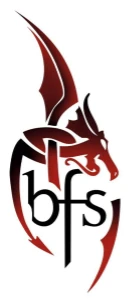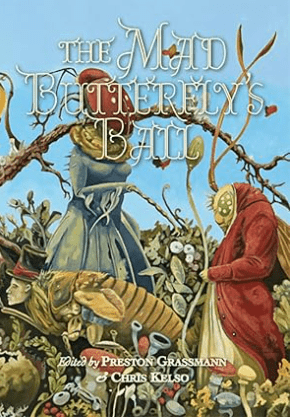
For all things fantasy, horror, and speculative fiction

Review Details
Review type: Book
Title: The Mad Butterfly’s ball
Editor: Preston Grassman & Chris Kelso
Publisger: PS Publishing
Release date: 1st June 2024

Reviewed by: Pauline Morgan
Other details: Trade Paperback RRP £15.99
The Mad Butterfly’s ball by Preston Grassman & Chris Kelso
Book Review
Pauline Morgan
There are a number of creatures that provoke terror in more people than any others. At the top of that list are spiders and snakes, followed closely by dogs and insects. It is not surprising then that horror stories have been woven about such creatures and that they make appearances in anthologies. Allen Ashley’s excellent anthology, Creeping Crawlers, brought together stories of anything that fell into that category, but there are always more possibilities. The Mad Butterfly’s Ball is another anthology of stories and poems featuring various creepy crawlies.
This is a beautifully produced book with a superb surreal and bizarre cover featuring the artwork of Richard A. Kirk. The interior contains more magnificent artwork, and each story/poem is prefaced with a small sketch of the featured creature.
Not all the items within are original to this anthology but have been chosen to expand the breadth of the theme. What is missing is a list of the first publications of the more historic pieces and what is original to this anthology. In some of the older stories, it is well to remember that some of the views at the time may differ from current sensibilities. The H.G. Wells story, ‘Empire of the Ants’ was originally published in 1905 but is still unsettling. Ants are a highly organised species, and in this scenario, one of the more aggressive forms is found to be spreading down the Amazon, killing humans as they advance and are unstoppable. The implication is that they could over the next half century take over all of South America. In Algernon Blackwood’s 1915 story ‘An Egyptian Hornet’ the author uses the encounter of Reverend Milligan with the insect as a vehicle to expose the apparently pious man’s contempt for Mullins who he regards as a baser person but who shows more courage when dealing with the dangerous insect. Creepy crawlies can form the basis of ghost stories, such as in E.F. Benson’s 1912 story ‘Caterpillars’. Set in an Italian villa, the narrator believes sees a swarm of foot-long caterpillars covering a bed in an empty room before migrating to another. These ghostly creatures are harbingers of death.
Most of the stories are written by current authors, some very well known in the horror field, such as Ramsey Campbell. Many insects go through a pupal stage between larva and adult. In Campbell’s story ‘Wrapped Up’, tomb robbers in Egypt awaken giant pupae that have been waiting thousands of years to emerge. In ‘Hivehead’, Paul di Filippo takes bees as his focus. This has a futuristic in which a genetically altered person acts as a hive for a swarm of bees to carry his passengers to areas where they are needed for pollination duties.
Almost everything is someone’s phobia, but certain creepy crawlies generate more disgust and fear than others. In ‘The Man From Nowhere’ by Eugen Bacon, a woman whose husband has vanished takes a stranger into her life as a replacement. It takes a while for her to realise he is a giant cockroach. This story is set in Africa, but Thomas M. Disch’s ‘The Roaches’ takes place in Manhattan. Marcia, who hates cockroaches, suddenly finds that she is able to control them. The start was getting them to drive out unpleasant neighbours.
Social insects are a common theme amongst these stories, probably because a single specimen is relatively harmless, but when they act co-operatively they can become dangerous, and scary. In ‘The Dream of Aninosuke’ by Lafcadio Hearn, a young man is taken, in a dream, to live in an ant colony. While this is a benign story, ‘After the Flood’ by Anna Tambour has a narrator who is obsessed with ants. Not all of these stories are horrific, except maybe to an outsider. In ‘Eejelé’ by Nuzo Onoh, the ants are benign, but the villager would not think so if they knew what had really happened to Eejelé’s body after her death.
One of the ideas behind this anthology is to explore all aspects of insect life, including the positive aspects. ‘Warning Wings’ by Arlton Eadie is the tale of a moth that appears to tap out a Morse code warning, resulting in the rescue of the crew of a ship. ‘The Butterflies of Eastern Texas’ by Kij Johnson is magical in many ways. There are plenty more insects in this book, some expressing the cultural background of the writer.
Insects have long inspired poetry, such as Emily Dickinson’s ‘Death is Like the Insect’ and D.R.G. Sugawaea’s ‘Ladybug’. Clive Barker’s poem ‘Upon a Milk Warm Dawn’ is beautifully crafted. It is a pity that he used dragonfly instead of mayfly as inspiration. The latter lives for just a day, while the former cruises the waterways for several months. As long as you do not have a phobia of insects, this is a good book to dip into.
Tags: HorrorPS PublishingShort story collection
Category: Book Review
All reviews
Latest Reviews:
- Girl Dinner by Olivie Blake
- The Swan’s Daughter by Roshani Chokshi
- Out of the Past, Tales of Haunting History edited by Aaron Worth
- Witchborne by Rachel Grosvenor
- Shattered Reality . Call of Cthulhu Scenario Anthology
- The Flesh King by Richard Kadrey
- The Haunted Vintage Marjorie Bowen
- Daughters of Nicnevin by Shona Kinsella
- Katabasis by R. F. Kuang
- Opposite World by Elizabeth Anne Martins
Review tags:
Action (48) Adventure (69) Angry Robot Books (11) Contemporary Fantasy (15) Fantasy (116) Gothic Horror (12) Harper Voyager (12) Historical Fantasy (14) Hodderscape (11) Horror (71) Orbit Books (33) Romance (28) Science Fiction (34) Titan Books (35) TorDotCom (12)
Leave a Reply